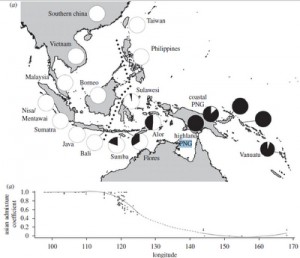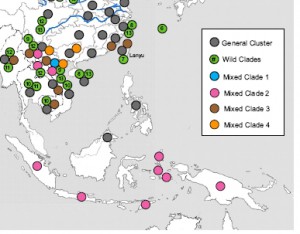- Another day, another tree disease threatens the British landscape.
- Some Swedish trees are not doing too well either.
- Seeds of Trade. A virtual book at the NHM. Lots of info on the history of crops.
- What are the pollination needs of a particular crop? FAO will tell you if you ask nicely.
- Purple tea in Kenya. Luigi’s mother-in-law not impressed.
Early farmers got high on chickpeas?
![]() A somewhat cryptic comment a few days ago on a year-old post on domestication eventually led us to an intriguing 2007 article in The Times which we unaccountably seem to have missed the first time around. The article quotes liberally from a Journal of Archaeological Science paper which puts forward something of an unorthodox take on chickpea domestication. 1
A somewhat cryptic comment a few days ago on a year-old post on domestication eventually led us to an intriguing 2007 article in The Times which we unaccountably seem to have missed the first time around. The article quotes liberally from a Journal of Archaeological Science paper which puts forward something of an unorthodox take on chickpea domestication. 1
The authors, from various Israeli institutions, start by saying that chickpea is an unusual member of the “founder package” of Middle Eastern crops, which also includes diploid einkorn wheat, tetraploid emmer wheat, barley, pea, lentil and bitter vetch. That’s because its wild precursor (Cicer reticulatum), unlike those of the other first crops, has a relatively narrow distribution and an indehiscent pod (that is, the pods don’t split open when the seeds are ripe), and the crop itself is grown in the summer rather than the winter, basically to escape the fungal disease Ascochyta blight. A rare precursor and a problematic agronomy: why bother with the damn thing? There must have been something special — or at least different — driving the domestication of chickpea. That something, according to the authors, is the amino acid tryptophan.
Free tryptophan levels are an average of three times higher in seeds of cultivated chickpeas compared to their wild precursor, but with a lot of variation among cultivars. The usual sorts of processing have no effect. The levels are such that the authors are able to suggest that “consuming domesticated chickpea will elevate the levels of tryptophan available for processes other than growth and maintenance.” What processes might these be?
Tryptophan is a precursor of the neurotransmitter serotonin in the brain. More tryptophan in the diet means more tryptophan in the blood which means more serotonin in the brain, which has a whole suite of interesting effects. Apart from a feeling of satiety, these include higher ovulation rates in women, improved performance under stress, lowering of aggression and greater receptivity.
So the authors are suggesting that early farming communities consuming wild chickpeas would have been more fertile, less hungry, less depressed, more accepting of social complexity, more innovative and more self-confident. Sounds like I should be eating more chickpeas. Anyway, recognizing the effect that eating these wonder grains had on their mood — and farm animals are apparently able to recognize high tryptophan feeds — early farmers would have selected for ever higher levels, leading to the domestication of the species: “it seems that the inclusion of chickpea in the founder crop package is best understood in light of its high nutritional seed properties.”
Well, it’s a great story, and I really hope it turns out to be true, although I’m not entirely sure how one might further test the hypothesis. Shades of the tale of the domestication of coffee. But I think it might be worth revisiting that initial assumption. Is chickpea really all that different from the other members of the founder package? The distribution of its precursor is certainly limited compared to some of the cereals (the map is courtesy of GBIF).
But wild lentils are not exactly common, and much more inconspicuous. And anyway we don’t really know what the distribution of C. reticulatum was like in the Neolithic. Its pollen doesn’t turn up in cores, according to one expert I asked, so it’s going to be difficult to reconstruct its ancient distribution and frequency. And why should seed indehiscence make chickpea a poor candidate for domestication? Wouldn’t it have been just the opposite? What about tryptophan levels in the other early legumes? And finally, as suggested by a former legume breeder I consulted, was Ascochyta blight a problem in the Neolithic? And is C. reticulatum susceptible to it anyway?
It does seem that perhaps the authors may have erected a bit of a straw man, which they then attacked with a very ingenious, utterly plausible, but ultimately unnecessary argument. But that’s not going to stop me eating my pasta e ceci a bit more often than before I read this paper.
Evolution of a weedy rice
Need to get the whole paper, but this analysis of the relatedness of weedy red rice and cultivated rice in Arkansas suggests that the diversity of the wild, weedy typ is large because (?) it evolved “in a region devoid of other weedy and wild Oryza species.”
Summarizing livestock domestication
You want a rapid gallop through what we have learned about livestock domestication from molecular markers? Here it is, courtesy of Groeneveld et al. Deep breath…
For all domestic species, mtDNA data have allowed the elucidation of the relationships with wild ancestor species, and for most species it is also informative at the intercontinental level… Sheep, goats, and taurine cattle (Bos taurus) are presumed to have been domesticated in Southwestern Asia. The Indus valley has been proposed to be the site of domestication of indicine cattle and the river type of water buffalo, while the swamp type of water buffalo is thought to have originated in the Yangtze valley. The domestication of pigs is considered to have happened across Eurasia and Eastern Asia in at least seven separate events involving both European and Asian subspecies of boar. The Yak is presumed to be the result of a single domestication event in China/Tibet with at least three maternal lineages contributing to the ancestral yak gene pool. Domestic chickens are thought to be the result of multiple domestication events, predominantly of Red jungle fowl (Gallus gallus) in Southeastern Asia and possibly also involving Gallus sonneratii and maybe Gallus lafayettii. Horses were domesticated in a broad area across the Eurasian steppe, and in this species the husbandry style has left considerable signatures. It is presumed that mares were domesticated numerous times, but that only a few stallions contributed to the genetic make-up of the domestic horse. The last finding illustrates the use of Y-chromosomal haplotypes as a marker for mammalian patrilines. This is still limited by the identification of haplotypes, but probably has the same potential as in human population genetics.
Quite a tour de force, I think you’ll agree. Read the paper itself for trenchant summaries of the results of literally dozens of molecular studies on these species, describing the relationships among breeds and geographic patterns in diversity. But if you’re just interested in the general principles, here they are:
- There is evidence of multiple domestication events for most species.
- These often involved more than one ancestor species or subspecies and
- repeated introgression events of closely related ancestor species.
- Genetic variability declines with increasing distance from centres of domestication.
- All species show strong geographic structure in genetic diversity, except sheep.
- Most of the genetic diversity is present within a breed and not between breeds.
The most interesting thing to me is the geographic structure, and the one thing the paper doesn’t do in any great detail is compare and contrast the patterns found in the different species. I mean, are horse breeds from Iberia more distinct from other European horse breeds than its cattle breeds are from other European cattle breeds, say? And if so, why? The paper describes the patterns found in each species, but doesn’t set them side-by-side, as it were. Once someone does that, we can go on to compare them with what we know about crops…
Crossing the Wallace Line
Dienekes’ Anthropology Blog has an intriguing map from a paper on human genetic diversity in island South East Asia showing a sharp cline across Wallace’s Line.
The genetic cline corresponds to a cline in phenotype which was actually recognized by Wallace himself. 2 The authors…
…conclude that this phenotypic gradient probably reflects mixing of two long-separated ancestral source populations—one descended from the initial Melanesian-like inhabitants of the region, and the other related to Asian groups that immigrated during the Paleolithic and/or with the spread of agriculture. A higher frequency of Asian X-linked markers relative to autosomal markers throughout the transition zone suggests that the admixture process was sex-biased, either favouring a westward expansion of patrilocal Melanesian groups or an eastward expansion of matrilocal Asian immigrants. The matrilocal marriage practices that dominated early Austronesian societies may be one factor contributing to this observed sex bias in admixture rates.
There’s a map of the same region in the recent paper on pig domestication that’s been in the news lately.
Compare and contrast. Still two quite distinct populations, but the placing of the line of demarcation is somewhat different. This is what the authors have to say about the Pacific pigs, after their main discussion, which is of their separately domesticated Chinese cousins:
This genetic evidence also supports separate domestication pathways (however independent) of one population in India and three wild boar populations indigenous to Peninsular Southeast Asia. Given the relative geographic proximity of the Southeast Asian clades, it is possible that the domesticated haplotypes were all present in a single population of wild boar, as is the case for modern Yaks. Regardless, only the Pacific Clade domestic pigs were transported out of Southeast Asia (to ISEA and the Pacific) before they were replaced in their homeland by domestic pigs derived from nonindigenous populations of wild boar.
So, people and pigs moving together across Wallace’s Line. How about crops? There are also distinct Pacific and Asian genepools in taro, though I could not find a nice map to compare directly with the above. However, the consensus seems to be — as also for crops such as bananas, yams, breadfruit, sugarcane and yams — that domestication happened southeast of the Wallace Line, in Sahul (Melanesia to be exact). As my friend and colleague Vincent Lebot said of these crops a few years back 3:
We now have biomolecular evidence to suggest that most cultivars were not brought by the first settlers from the Indo-Malaysian region, but rather were domesticated from wild sources existing in the New Guinea and Melanesian areas… In other words, the first migrants that went across Wallacea did not embark major domesticated plants if any, in their adventure.
Pigs, in other words, and maybe chickens, but not taro or yams. Banana went in the opposite direction. I wonder why. Or did people bring them on their adventure, and abandon them when they found better varieties?
Incidentally, coconut also shows a bit of a Wallacean dividing line, but of course it doesn’t need humans for its dispersal, at least not everywhere.


